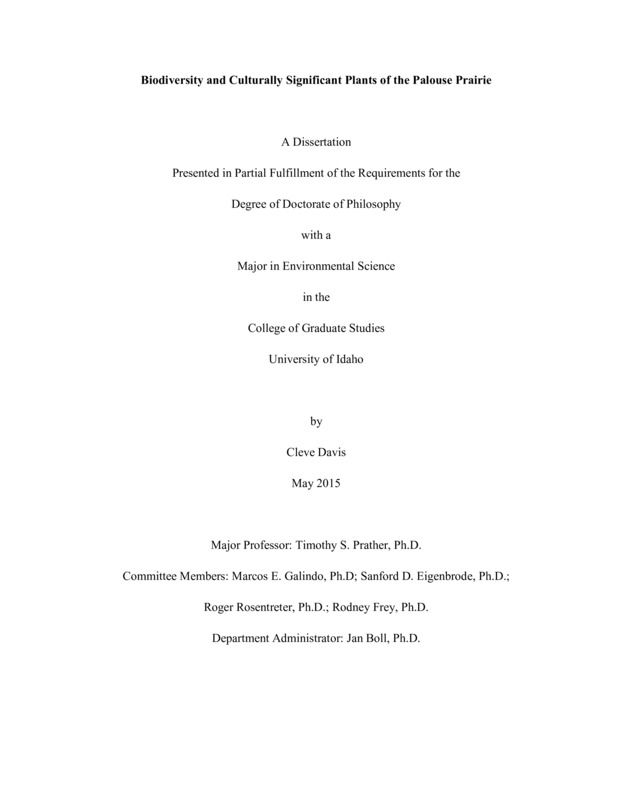Biodiversity and Culturally Significant Plants of the Palouse Prairie
Davis, Cleve. (2015). Biodiversity and Culturally Significant Plants of the Palouse Prairie. Theses and Dissertations Collection, University of Idaho Library Digital Collections. https://www.lib.uidaho.edu/digital/etd/items/davis_idaho_0089e_10535.html
- Title:
- Biodiversity and Culturally Significant Plants of the Palouse Prairie
- Author:
- Davis, Cleve
- Date:
- 2015
- Keywords:
- Biological Soil Crust Conservation Biogeography Diversity Ethnobotany Invasive Species Palouse Prairie
- Program:
- Environmental Science
- Subject Category:
- Ecology; Social research; Entomology
- Abstract:
-
This dissertation presents three manuscripts that assess the impacts of non-native grass invasion to biodiversity and identifies the social importance of conserving native flora on the Palouse Prairie. The Palouse Prairie is located northern Idaho and southeastern Washington where it has been estimated that less than 1% of the prairie remains and invasive non-native grasses are reducing the biodiversity. The manuscripts are entitled: "Effects of Non-native Grass Invasion and Landscape Structure on Plant and Pollinator Diversity in the Palouse Prairie of the Columbia Basin, USA"; "Biological Soil Crusts in Relation to Topography, Soil Depth, Non-native Grass Invasion, and Native Plant Diversity on the Palouse Prairie Grassland;" and "Social Values of Culturally Significant Plants on the Palouse Prairie".
The first manuscript identified relationships between native plant and bee pollinator diversity with landscape elements and non-native grass invasion. The analysis was done using a multi-scale approach. Five variables were found to be significant at predicting plant and pollinator diversity, which included: non-native grass cover, area-weighted mean patch size, patch richness, useful pollinator habitat, and distance to water. A negative relationship of annual non-native grass cover to native plant diversity was found to be significant.
The second manuscript focused upon biological soil crust (BSC) and non-native grass invasion by assessing the relationship with native plant diversity, elevation, aspect, soil depth, and slope. Using regression soil depth was found to be inversely related to BSC cover and native plant diversity positively related to BSC cover. We attributed these findings to the ability of BSC and native plants to thrive upon environmentally stressed soils better than non-native grasses. Nonnative grass cover was also found to be inversely related to native plant diversity. This finding was attributed to biotic resistance of native plant communities.
The third manuscript focused upon valuing the importance of culturally significant plants using interviews and sample surveys. The purpose of the study was to identify potential social support to conserve culturally significant plants. The study found that Native Americans interviewed and 36% of the respondents from the community considered culturally significant plants valuable.
- Description:
- doctoral, Ph.D., Environmental Science -- University of Idaho - College of Graduate Studies, 2015
- Major Professor:
- Prather, Timothy S
- Committee:
- Eigenbrode, Sanford D.; Galindo, Marcos E.; Rosentreter, Roger; Frey, Rodney
- Defense Date:
- 2015
- Identifier:
- Davis_idaho_0089E_10535
- Type:
- Text
- Format Original:
- Format:
- application/pdf
- Rights:
- In Copyright - Educational Use Permitted. For more information, please contact University of Idaho Library Special Collections and Archives Department at libspec@uidaho.edu.
- Standardized Rights:
- http://rightsstatements.org/vocab/InC-EDU/1.0/

